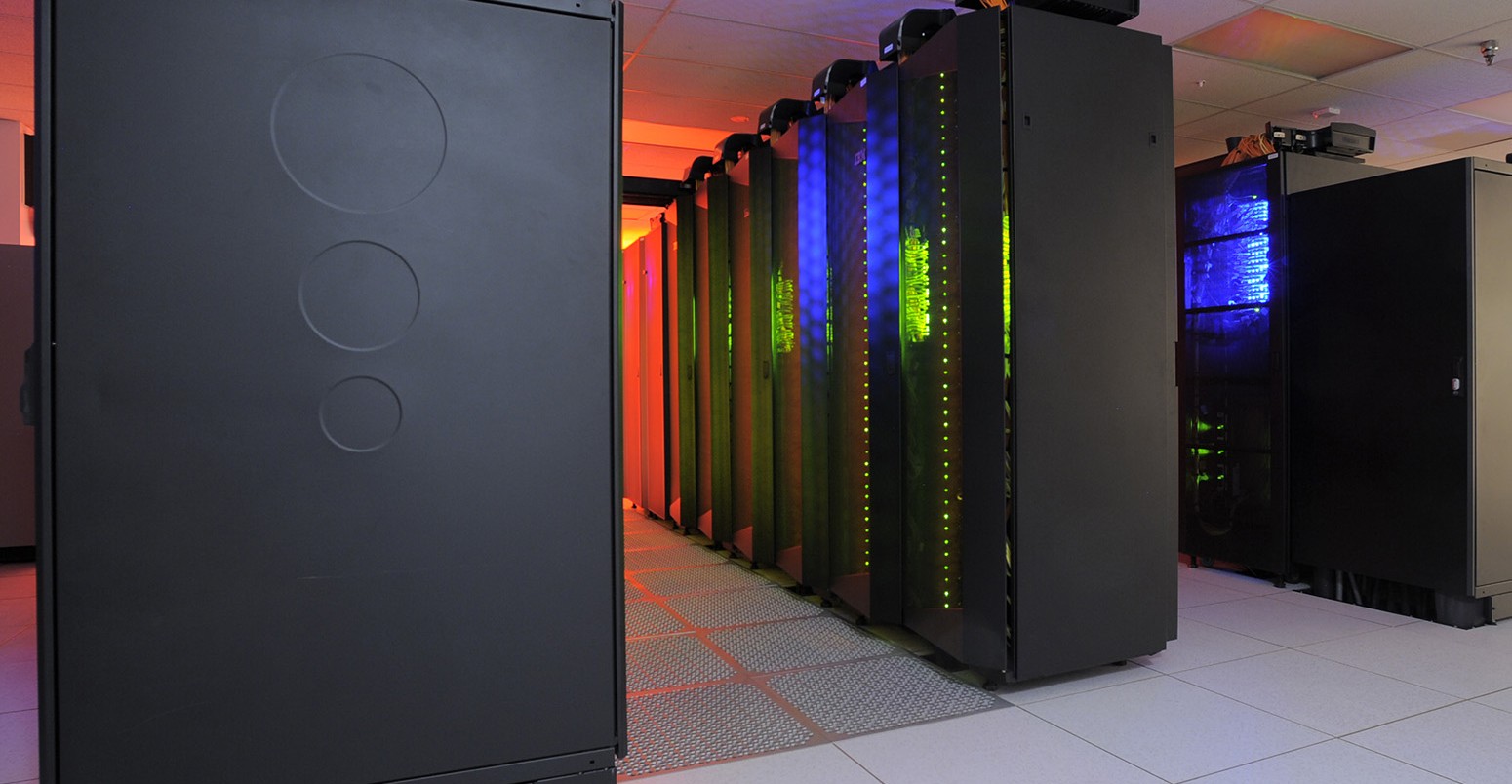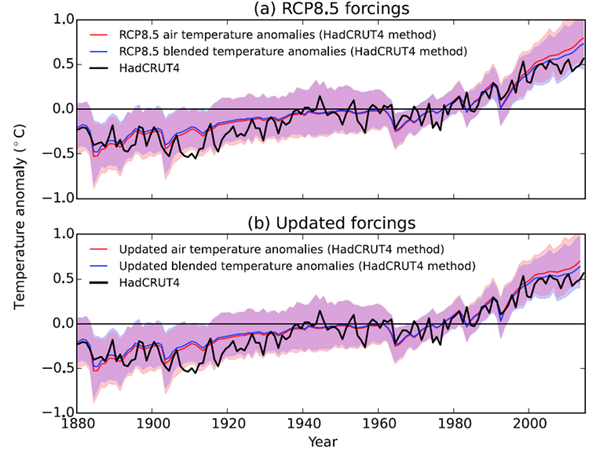
New study shrinks the gap between observed and modelled global temperatures
Roz Pidcock
07.31.15Roz Pidcock
31.07.2015 | 4:15pmIt’s well known in climate science that global surface temperatures over the past decade have been lower than climate models expected them to be.
Some parts of the media have jumped on this to suggest climate models overestimate the amount of warming we can expect in future.
Now, a new paper says the discrepancy between modelled and observed temperatures isn’t as large as previously thought.
Taking into account the different ways they estimate global temperature shrinks the difference between them by more than a third, according to the study in Geophysical Research Letters.
Model mismatch
While heat-trapping greenhouse gases in the atmosphere have continued to rise, recent measurements of surface temperatures suggest the world is warming a little more slowly than models projected.
The black line in the top graph below shows how the observed temperature from HadCRUT4 is currently tracking the lower end of the range expected by climate models used in the last Intergovernmental Panel on Climate Change report (red line and purple shading).
We’ll come back to the bottom graph in a minute.
Top: Comparison of 84 model simulations of the IPCC’s highest emissions scenario (RCP8.5) against HadCRUT4 observations (black), using air temperatures (red line and shading) or “blended” temperatures (blue line and shading). Coloured lines are the multi-model averages, shading is the 5-95% uncertainty range of the model simulations. Bottom: Results adjusted to include updated aerosol forcings from Schmidt et al. [2014]. Anomalies are relative to 1961-1990. Source: Ed Hawkins, Climate Lab Book
Sea surface warming
The new paper’s authors – a list of nine researchers from UK, US and Canadian Universities – say the discrepancy between modelled and observed datasets is at least partly because they estimate global temperature in different ways.
Global temperature in climate model simulations is typically calculated using only air temperatures, whereas observational records are based on a “blend” of measurements taken from the air above land and from the surface of the ocean.
When the team adjusted the models to be consistent with the way observational records measure global temperature, the discrepancy shrunk by 38% over the period 1975-2014 (blue line in the top panel above).
Put another way, the trend in global temperature from observation is about 0.017C per decade lower than it would be if it was based on air temperature alone. The reason is that the sea surface tends to warm more slowly than the air over the ocean, the paper explains.
Climate models calculate global temperature using air temperatures above the ocean surface (right) whereas the observational record is based on the temperature in the top few metres of the ocean (left). Source: University of York briefing
It’s well known that HadCrut4 doesn’t have good coverage in the Arctic. This affects the global temperature estimate because the Arctic is warming faster than the global average. The paper addresses this by reducing global coverage in the models to match where we have observations.
You can read more about the study over at Climate Lab Book, run by co-author Dr Ed Hawkins from the University of Reading. The University of York, where lead author Dr Kevin Cowtan is a researcher, has a handy briefing explaining some other differences the team noticed to do with how observations and models deal with diminishing sea ice in the Arctic.
The past decade
If you take just the past five years from 2009-2013, the new paper’s adjustments reduce the discrepancy between models and observations by less than over the longer period between 1975-2014, by 27% compared to 38%.
There are a number of reasons why observed temperatures might have been lower than models expected over the last decade or so, scientists say. It’s thought the main reason is natural cycles pushing more heat into the deep ocean rather than keeping it at the surface.
Other contributions could be coming from an increase in small volcanic eruptions, a reduction in solar activity, a drop in water vapour in the stratosphere and an increase in the amount of sunlight-reflecting particles in the atmosphere, known as aerosols.
The bottom graph above shows what happened when the team adjusted their results to include an updated estimate of aerosols and other forcings by NASA’s Dr Gavin Schmidt. The modelled temperature (blue line) gets even closer to the observations (black line).
Interestingly, when the team took the most recent decade and all its fluctuations out of their analysis, the gap between modeled and observed temperatures was almost completely eliminated, suggesting the discrepancy is only very recent in origin.
As Cowtan says in the University of York briefing:
“Recent studies suggest that the so-called ‘hiatus’ in warming is in part due to challenges in assembling the data. I think that the divergence between models and observations may turn out to be equally fragile.”
“Apples-to-apples”
This isn’t the first time scientists have noticed the different ways models and observational records work out global temperature, Hawkins tells Carbon Brief. But scientists haven’t carried out such a comprehensive study of the consequences before, he says.
Before they started, the team didn’t know whether aligning the two methods would increase or decrease the gap between models and observations. Hawkins says:
“It could have been that the corrections could have gone the other way, but it would still have been a better way to present the data. As it turns out, these corrections help explain part of the apparent divergence between the observations and models.”
So, which of the two approaches should we use to get the best picture of global temperature?
Scientist can’t change the way Earth’s surface temperature has been measured in the past, says Hawkins. So, it would make sense to adjust the model temperatures to be consistent with the observations. He tells Carbon Brief:
“I think the sensible approach is to extract the data from the models as if they were observations.”
Doing it the other way round – adjusting observed temperatures to be consistent with models – is more tricky, says Hawkins. The change would depend on the specific model, since they would all slightly different in the corrections they would apply.
What’s important, the paper notes, is to recognise when a comparison between models and observed global temperatures is an “apples to apples” one and when it’s not, so that we can make a fairer assessment of how well they’re performing against real world temperatures.
Main image: The heart of the NASA Center for Climate Simulation is the Discover supercomputer.
Cowtan, K. et al., (2015) Robust comparison of climate models with observations using blended land air and ocean sea surface temperatures. Geophysical Research Letters. Doi: 10.1002/2015GL064888
-
New paper says the discrepancy between modelled and observed temperatures isn't as large as previously thought



